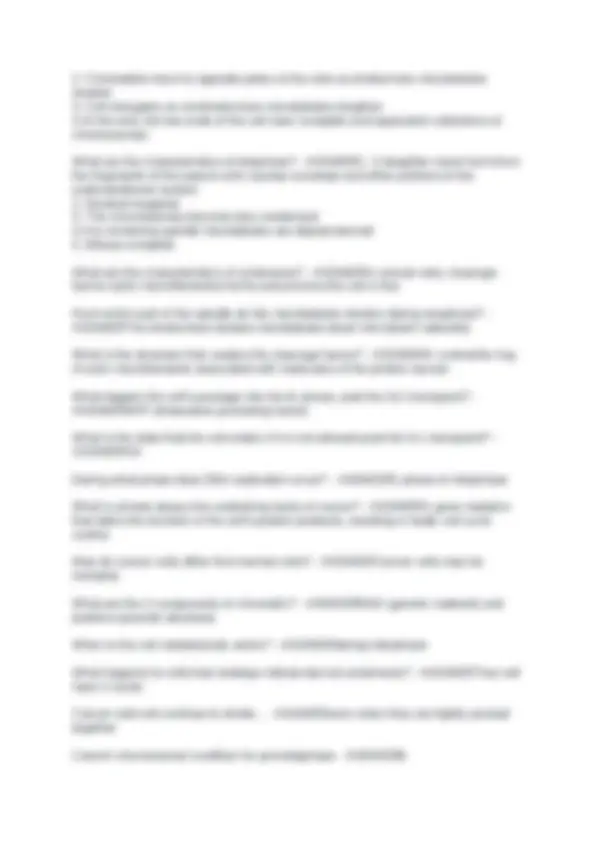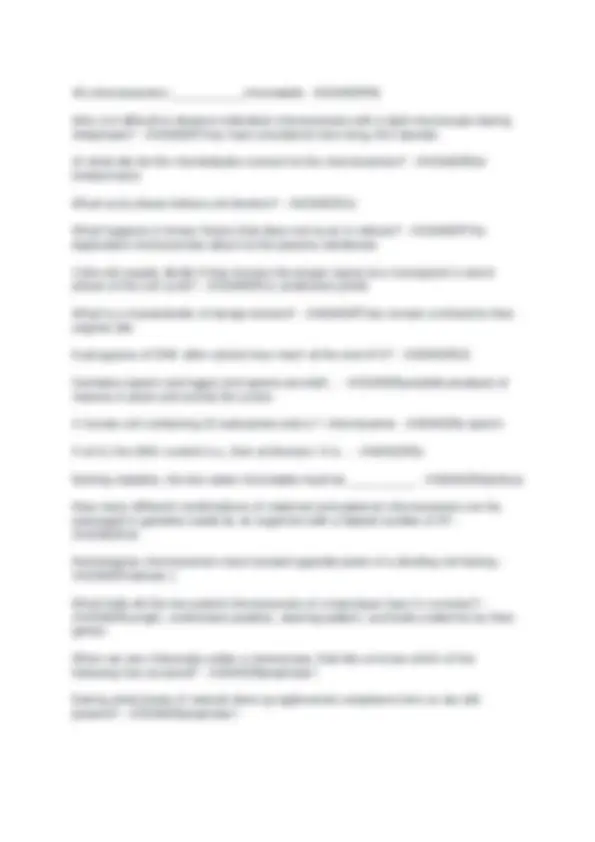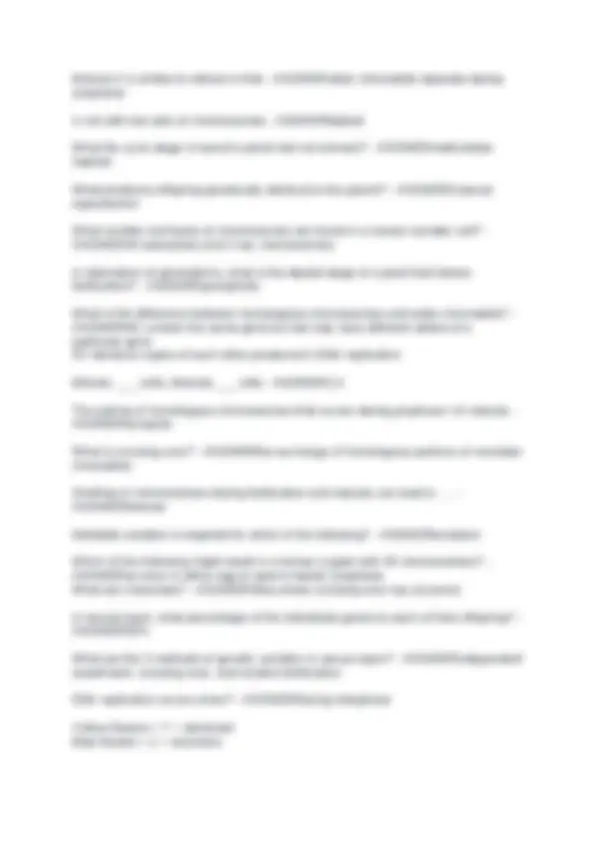





Study with the several resources on Docsity

Earn points by helping other students or get them with a premium plan


Prepare for your exams
Study with the several resources on Docsity

Earn points to download
Earn points by helping other students or get them with a premium plan
Community
Ask the community for help and clear up your study doubts
Discover the best universities in your country according to Docsity users
Free resources
Download our free guides on studying techniques, anxiety management strategies, and thesis advice from Docsity tutors
A comprehensive set of questions and answers covering key concepts related to cell division and meiosis, including mitosis, meiosis, and the cell cycle. It is a valuable resource for students studying biology, particularly those enrolled in biol 1201. Topics such as the stages of mitosis and meiosis, the role of chromosomes and sister chromatids, and the differences between sexual and asexual reproduction.
Typology: Exams
1 / 7

This page cannot be seen from the preview
Don't miss anything!




Define the cell cycle - ANSWERthe life of a cell from formation to its own division Most cell division results in daughter cells with identical ___________ - ANSWERgenetic information (DNA) What are the reasons for cell division? - ANSWERReproduction (unicelluar organisms), Growth and Developement (multicellular organisms), Tissue renewal (replacing damaged cells ex. liver) Define the genome - ANSWERThe whole of the genetic information of an organism What is the DNA of a cell packaged in? - ANSWERChromosomes Define chromosomes - ANSWERlong, thin threads of chromatin associated with many protiens that maintain the structure and help control gene activity Define chromatin - ANSWERthe entire complex of DNA and proteins that is the building material of chromosomes What form of cell division do somatic (nonreproductive) cells undergo? - ANSWERMitosis Somatic cells have ____ sets of chromosomes - ANSWERtwo (diploid) What form of cell division do gametes (reproductive cells) undergo? - ANSWERMeiosis Gametes have ____ as many chromosomes as somatic cells. - ANSWERhalf (haploid) Define sister chromatids - ANSWERtwo identical chromatids that are joined Define centromere - ANSWERSpecialized region where 2 sister chromatids and has associated enzymatic activity Chromosome duplication - ANSWERoccurs in the S phase of the cell cycle and is necessary prior to mitosis The Mitotic (M) phase contains which two processes? - ANSWERMitosis and Cytokinesis What happens during interphase? - ANSWERThe cell grows, performs its duties, copies its DNA, and prepares for cell division (90% of cycle)
The cell grows during all three phases of interphase, but the chromosomes are only duplicated during the _______ phase - ANSWERS (Synthesis) Mitosis is divided into 5 phases - ANSWERprophase, prometaphase, metaphase, anaphase, telophase When does the mitotic spindle form? - ANSWERduring prophase What is the mitotic spindle made of? - ANSWERmicrotubules What is the function of the centrosome during cell division? - ANSWERorganize microtubules to pull chromatids apart What are the characteristics of prophase? - ANSWER1. The chromatin fibers condense into discrete chromosomes
46 chromosomes=___________chromatids - ANSWER Why is it difficult to observe individual chromosomes with a light microscope during interphase? - ANSWERThey have uncoiled to form long, thin strands At what site do the microtubules connect to the chromosomes? - ANSWERthe kinetochores What cycle phase follows cell division? - ANSWERG What happens in binary fission that does not occur in mitosis? - ANSWERThe duplicated chromosomes attach to the plasma membrane Cells will usually divide if they receive the proper signal at a checkpoint in which phase of the cell cycle? - ANSWERG1 (restriction point) What is a characteristic of benign tumors? - ANSWERThey remain confined to their original site 8 picograms of DNA after cytosis-how much at the end of S? - ANSWER Gametes (sperm and eggs) and spores are both... - ANSWERpossible products of meiosis in plant and animal life cycles A human cell containing 22 autosomes and a Y chromosome - ANSWERa sperm If at G1 the DNA content is x, then at Meiosis I it is... - ANSWER2x Barring mutation, the two sister chromatids must be __________ - ANSWERidentical How many different combinations of maternal and paternal chromosomes can be packaged in gametes made by an organism with a diploid number of 8? - ANSWER Homologous chromosomes move toward opposite poles of a dividing cell during - ANSWERmeiosis 1 What traits do the two paired chromosomes of a karyotype have in common? - ANSWERLength, centromere position, staining pattern, and traits coded for by their genes When we see chiasmata under a microscope, that lets us know which of the following has occurred? - ANSWERprophase I During what phase of meiosis does synaptonemal complexes form or are still present? - ANSWERprophase I
Meiosis II is similar to mitosis in that - ANSWERsister chromatids separate during anaphase A cell with two sets of chromosomes - ANSWERdiploid What life cycle stage is found in plants but not animals? - ANSWERmulticellular haploid What produces offspring genetically identical to the parent? - ANSWERAsexual reproduction What number and types of chromosomes are found in a human somatic cell? - ANSWER44 autosomes and 2 sex chromosomes In alternation of generations, what is the dipolid stage of a plant that follows fertilization? - ANSWERsporophyte What is the difference between homologous chromosomes and sister chromatids? - ANSWERHC-contain the same gene loci but may have different alleles of a particular gene SC-identical copies of each other produced in DNA replication Mitosis- ___ cells; Meiosis-___ cells - ANSWER2, The pairing of homologous chromosomes that occurs during prophase I of meiosis - ANSWERsynapsis What is crossing over? - ANSWERthe exchange of homologous portions of nonsister chromatids Shuffing of chromosomes during fertilization and meiosis can lead to ..... - ANSWERMeiosis Heritable variation is required for which of the following? - ANSWERevolution Which of the following might result in a human zygote with 45 chromosomes? - ANSWERan error in either egg or sperm meiotic anaphase What are chiasmata? - ANSWERSites where crossing over has occurred. In sexual repro, what percentage of the individuals genes to each of their offspring? - ANSWER50% What are the 3 methods of genetic variation in sexual repro? - ANSWERIndependent assortment, crossing over, and random fertilization DNA replication occurs when? - ANSWERDuring interphase Yellow flowers = Y = dominant Blue flowers = y = recessive
Which of the following was discovered by Thomas Hunt Morgan? - ANSWERcrossing over (homologous recombination) If Y = yellow flowers = dominant y = blue flowers = recessive You cross a yellow plant (of unknown genotype) with a blue plant and the F generation is all yellow. This means that the genotype of the yellow plant is: - ANSWERYY To document the occurrences of a particular trait or possible disorder across different generations of your family, which genetic tool would you use? - ANSWERpedigree Genes A and B are separated by 60 centimorgans, genes C and D are separated by 12 centimorgans. Which of the following is true? - ANSWERGenes A and B cross over during meiosis more frequently than genes C and D Y = yellow flowers = dominant y = blue flowers = recessive If you cross a yellow plant (of unknown genotype) with a blue plant and the F generation is half yellow and half blue flowered plants, this means that the unknown plant's genotype is: - ANSWERYy Which of the following possible chromosomal problems does NOT happen during crossing over / homologous recombination? - ANSWERnondisjunction Y = yellow flower = co-dominant y = blue flower = co-dominant If you cross a yellow plant (of unknown genotype) with a blue plant and F generation all have green flowers. This means that: - ANSWER When gene A controls the expression of the phylogenetic trait for gene B, this is called: - ANSWERepistatis You are studying a fully adult organism that has a haploid genome, but it is not a gametophyte plant or a fungus or a protist, this means that it is probably: - ANSWERa male insect